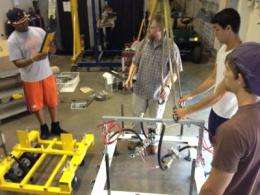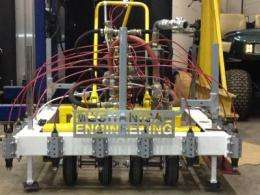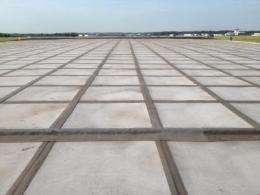Researchers transform machine to make runways safer

Clemson researchers redesigned and modified a mobile drill press to retrofit a section of a runway that halts overrun aircraft, ultimately minimizing aircraft damage and passenger injury.
The process of retrofitting the end of a runway at Greenville Downtown Airport required more than 80,000 holes to be drilled in the concrete. Pace Pavement Technologies Inc. recognized that manually drilling the holes was not an option and there needed to be a more efficient and accurate way to drill.
"We visited several machine shops and pneumatic suppliers and received minimal assistance in the design and build of a mobile drill press," said Carl Pace, president of Pace Pavement Technologies Inc. "Clemson University stepped up to the challenge and enjoyed taking on this project."

Seven Clemson University student researchers and their faculty adviser met with representatives from Pace Pavement Technologies Inc. to discuss the design problems and challenges related to their mobile drill press.
"We needed to reduce the weight of the machine by half so as to not cause any damage to the pavement underneath," Pace said.
The students began by redesigning the undercarriage and modifying the wheels to evenly spread the weight of the machine and reduce ground pressure.

"Clemson University student researchers truly went above and beyond their call of duty by not only reducing the ground pressure of the mobile drill press, but also improving the machine's overall performance and maneuverability," said Gregory Mocko, an assistant professor in Clemson's mechanical engineering department.
The students improved the overall performance of the machine by altering the plumbing, developing a gauge to adjust each drill simultaneously and adding a device that allows the operator to better control drill depth. They also published an operations and parts manual.
"I was overjoyed to have young minds really focused on this project," said Pace. "They gave this project the attention that it deserved and I truly hope we have the opportunity to work with Clemson again."
Provided by Clemson University


















